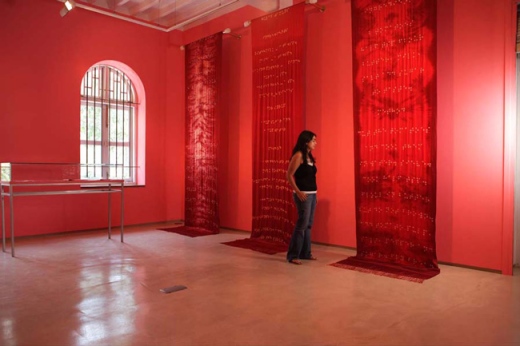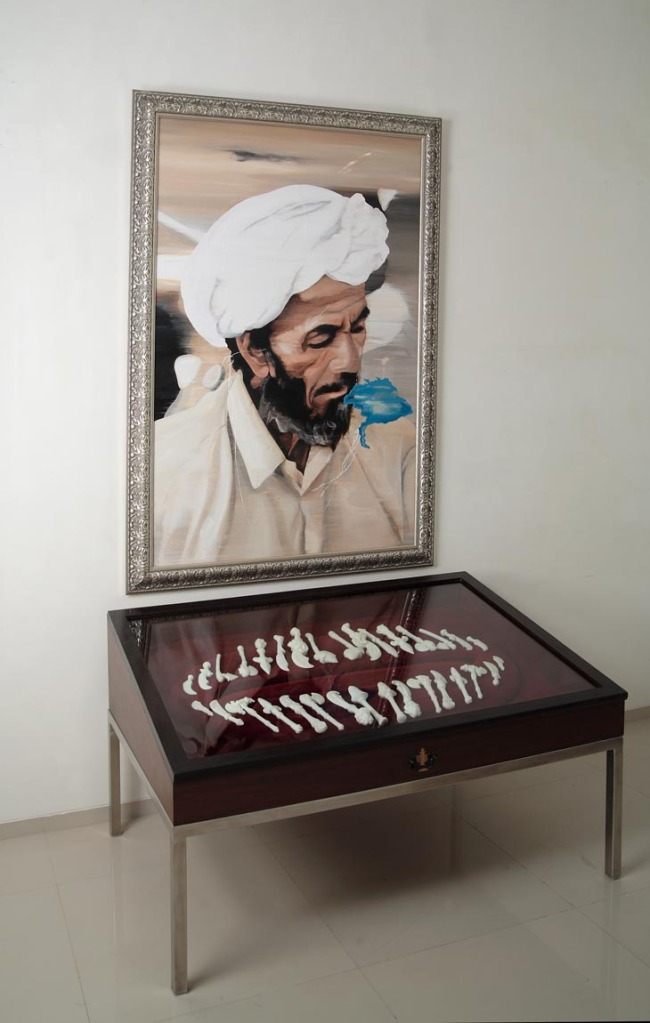INTERVIEW INDIAN CONTEMPORARY ART
Reena Kallat (1973) is one of the best-known Indian contemporary artists today. In this Art Radar Asia exclusive interview she discusses her influences, artists she admires, the contemporary art scene and the painstaking techniques used to create her renowned rubber stamp portraits.
Kallat has shown her work in many prestigious institutions including the Saatchi Gallery and Mori Art Museum in Japan.
Where were you born, brought up and schooled?
I was born in Delhi, although I was brought up in Mumbai all through my growing years where I went to school, followed by my training at Sir J.J. School of Art.
What have been major influences in your life and art?
If I had to think of one person who influenced my life tremendously, it would have to be my mother who helped inculcate several interests at an early age. Although she died when I was young, her absence continued to influence my life in more ways than one.
There are several artists whose works have impacted my Art and my sensibilities towards art making at different stages that include Frida Kahlo, Rachel Whiteread, Jenny Holzer, Mona Hatoum, Christian Boltanski, while closer home in India the practices of artists such as Nalini Malani, Vivan Sundaram, Arpita Singh, interested me and informed my early years.
How long does it take to produce an artwork? What kind of space do you work in?
I like working on multiple ideas at the same time and these could be at different stages of completion. Sometimes they collectively spark off unexpected adaptations. Most are kept fluid and provisional over a period time to see if they spawn into meaningful works.
My studio is on 2 levels, ground and first floor. I usually make work on the lower level and have my books to read, write or sketch on the upper level which allows me the space and sometimes necessary distance between conceiving an idea and realizing it.
What achievement in your art career are you most proud of?
Although there is a lot to be achieved I’m not someone who’s easily satisfied, given the expectations I have from myself. But to be a catalyst in realizing certain key works that have taken me a period of time to develop, such as the series of “Synonyms” made using rubberstamps, “Walls of the Womb” a series of tie and dye silks or the sculptural installation titled “Saline” made in bonded marble amongst others, has been fulfilling. I am glad to have been part of some interesting shows in venues such as the Helsinki City Art Museum, ZKM museum in Karlsruhe, the Chicago Cultural Centre, Hangar Bicocca in Milan, Zendai Museum of Contemporary Art, MOCA Shanghai, Henie Onstad Kuntsenter in Oslo, The National Gallery of Modern Art in Mumbai and Saatchi Gallery, London amongst others.
Are there any Indian artists you admire in particular?
Amongst the long list of artists from India whose work I have admired are Nasreen Mohamedi, Nalini Malani, Vivan Sundaram, Arpita Singh, Bhupen Khakkar, Gulam Sheikh, Nilima Sheikh, Atul Dodiya, Sheela Gowda, Surendran Nair besides some of my contemporaries like Anita Dube, Subodh Gupta, Jitish Kallat, Bharti Kher, Shilpa Gupta and N.S. Harsha.
We have been to the Saatchi show in London several times, and noticed that your art displayed there has been deeply influenced by historical events. How does history especially that of India, inspire you?
I think it is almost impossible to not be influenced either consciously or unconsciously by the richness of India’s vast cultural landscape through its architecture, film, crafts, dance, theatre. As we know, India has had long phases in its history of harmonious co-existence among divergent ethnic groups and communities, however in the recent past its political history has been tainted by divisive politics being played out, causing fissures amongst people. At times my work can be a comment or a critique but what interests me is that space in-between the factual and the fictional, of the sometimes harsh realities and the tender aspirations or dreams for a better future.
Could you please tell the story of how your Synonym (2007) came about? Why did you create it? How was it made?
My interest in using rubberstamps as a medium grew out of its use within official purposes and it’s associations with bureaucracy. I first started using them in 2003. I think of each name on the rubberstamp as being representative of an individual amidst hundreds of faceless people in this vast ocean of humanity. The sources of reference for the names often provide meaning or give context to the different bodies of works made.
In case of the Synonyms I chanced upon the list of names, out of official police records of those who’ve gone missing in India, through a friend who was looking for someone missing. The work stands like a screen holding up portraits formed by several hundred names of people rendered in scripts of over 14 Indian languages. From a distance they come together as portraits, but up-close they almost seem like a circuit-board of rubberstamps. These are people who seem to have slipped out of the radar of human communication, thrown off the social safety net.
Making these works is a slow process but one that throws up sometimes unexpected and startling results. I first draw out the silhouette of the portrait on plywood, then arrange the wooden pieces that comprise the rubberstamps. After painting the portrait on the uneven surface of the rubberstamps, the names are pasted and inked. These pieces are then transferred onto the Plexiglas where some additions and omissions lend the portrait its final character.
What are your future plans? Exhibitions?
I am toying with a bunch of ideas at this point, some of which are slowly taking shape in the studio while there are practical glitches in case of others that make the process equally challenging as it is exciting. Amongst some of the exhibitions I’m now making new work towards are for the Helsinki City Art Museum, Castel Sant Elmo in Naples later this year and the Kennedy Centre in Washington, scheduled early next year.
What are your thoughts on the contemporary Indian art scene in both the Indian and international contexts?
I think post independence it has taken a long time for India to find its place in the larger global context in most fields. Contemporary Indian Art has experienced a steady growth over the last few decades with contributions and efforts from previous generations of artists, writers, critics into developing the scene before its meteoric rise, largely attributed to the commercial success it was gaining. Given the collective vibrancy and sheer robustness of the Art being produced here, I think individual artists from India will increasingly be seen to be significant contributors to the global Art scene.
In the absence of the state’s responsibility in contributing to improve and enhance the infrastructure around Art, whether it is at the university level or at the institutional level, the private sector in India has played an important role. However there is still a lot of work that needs to be done to try and increase the presence of Art in the larger public consciousness.
AL/KCE
Related Posts
- Dinesh Vazirani CEO Saffronart speaks about 2010 market outlook for Indian art-Arttatic podcast – March 2010
- “The Empire Strikes Back – Indian Art Today” at Saatchi Gallery: critics’ review roundup – Feb 2010
- Indian artist Anish Kapoor’s solo at Royal Academy – what did the critics call it? Performance art and Turkish toilet – Jan 2010
- Indian artist Reena Kallat’s work mutates in Mumbai – Jan 2009







